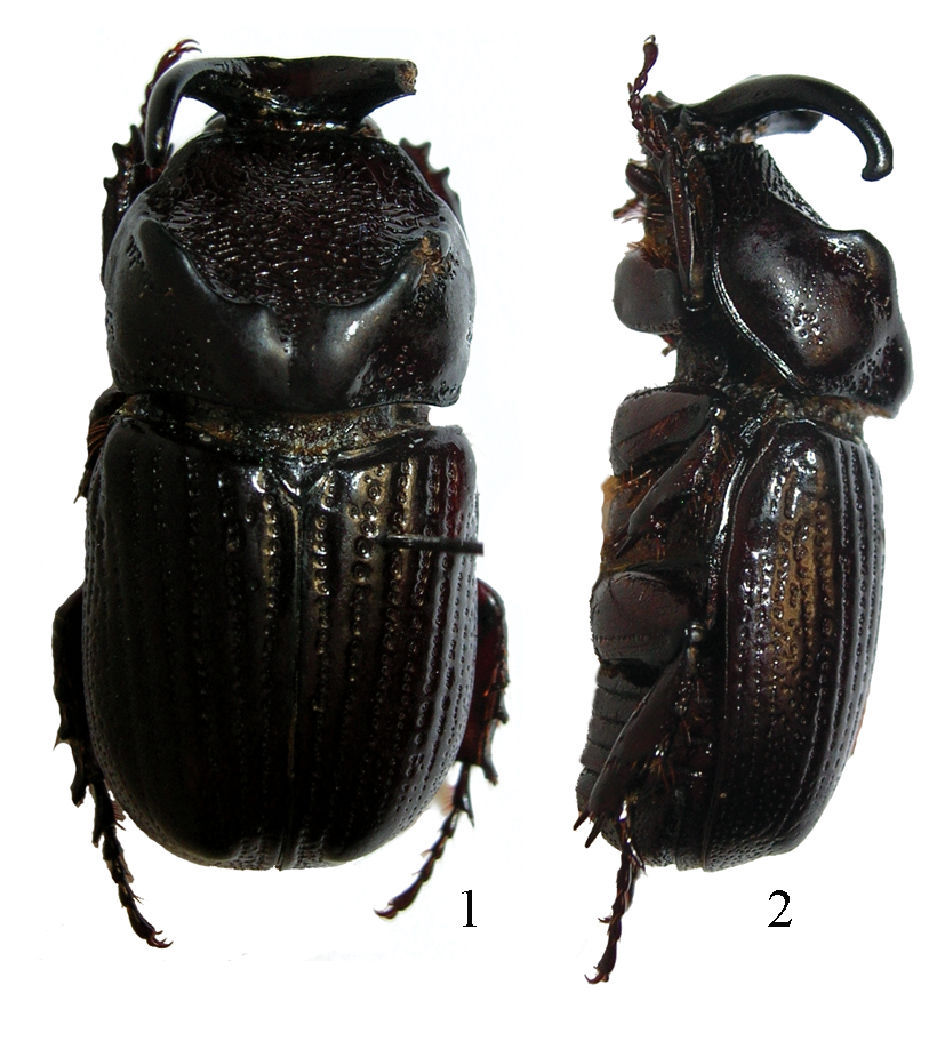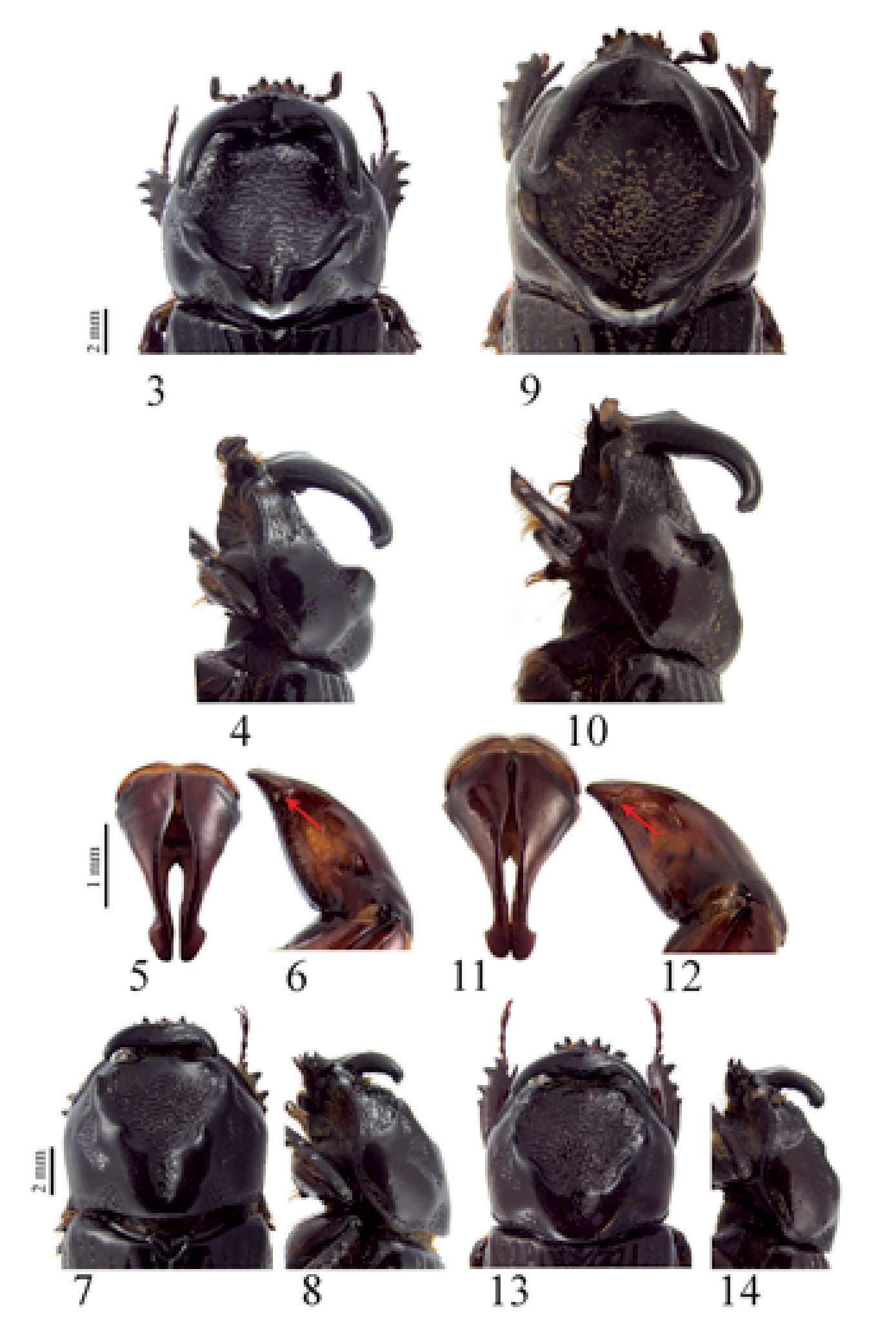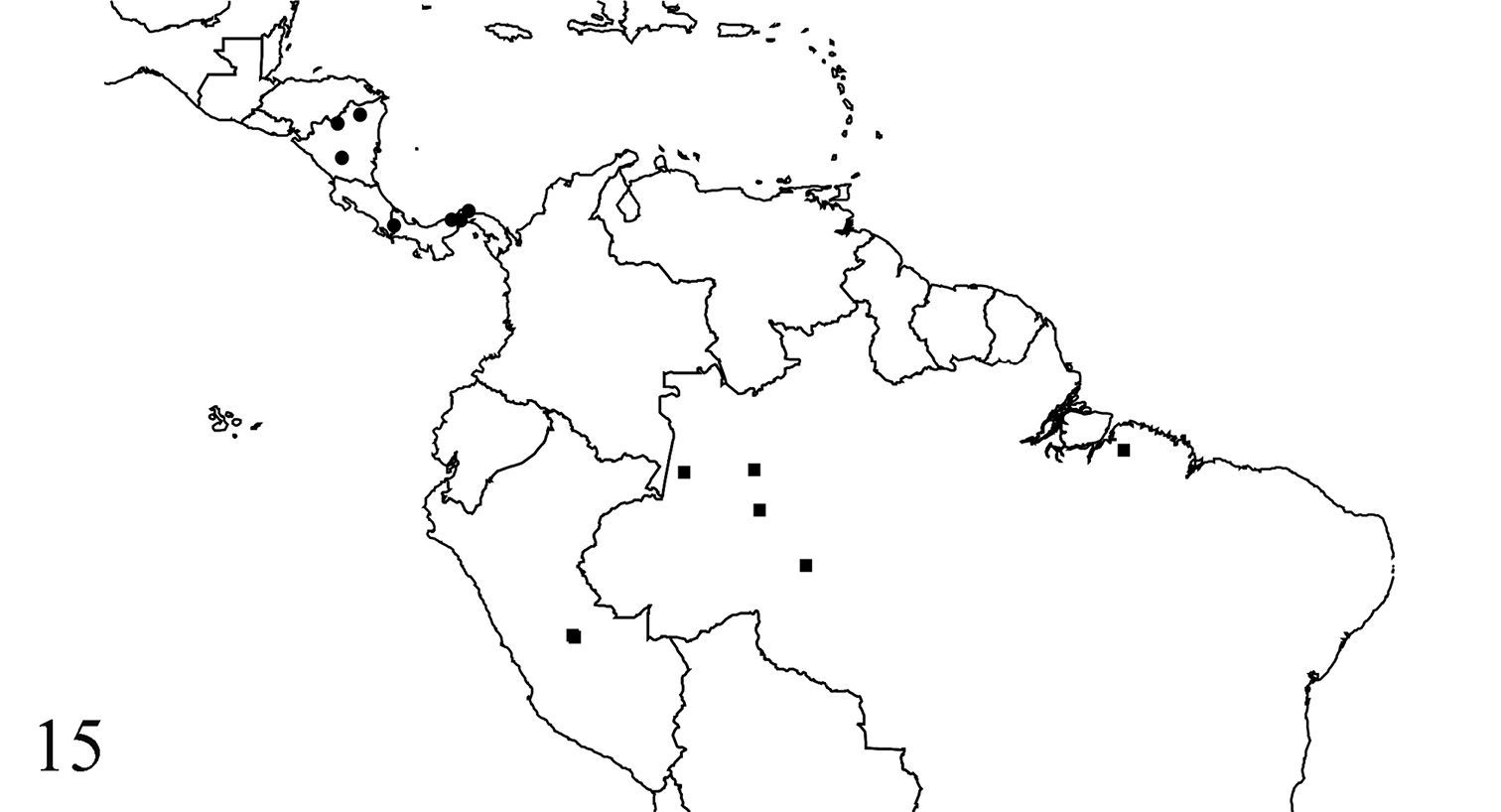(C) 2010 Paschoal Coelho Grossi. This is an open access article distributed under the terms of the Creative Commons Attribution License, which permits unrestricted use, distribution, and reproduction in any medium, provided the original author and source are credited.
For reference, use of the paginated PDF or printed version of this article is recommended.
A second species of Amblyodus Westwood, 1878, Amblyodus castroi sp. n., is described from the northern South America based on 12 specimens from Brazil and Peru (Amazonian subregion). The new species is here compared with the type species of the genus, Amblyodus taurus Westwood, 1878 and both species and their male genitalia are illustrated. Diagnostic characters for the genus are discussed, especially the metatibial teeth. A distribution map including the type species and the new species is provided. The genus Amblyodus is recorded for the first time from Peru and from Brazil states of Pará and Rondônia.
Amazonian subregion, Phileurini, South America, taxonomy
Amblyodus was described by
After studying these specimens and additional six specimens, three from Peru and three from Brazil, we concluded that all these material belong to a new species of Amblyodus which is here described and compared with the type species of the genus. The diagnostic characters are discussed. A distribution map is provided, including a new country locality from Peru.
Material and methodsThe specimens were examined under a dissecting
stereomicroscope at magnification of 0.8–50×. Description of external
morphological features and conventions follow in part
The phylogenetic species concept of
Specimens examined for this work were provided by seven
institutions and private collections. Acronyms for institutions are
mostly taken from
CEMT Coleção Entomológica da Universidade Federal do Mato Grosso, Cuiabá, MT, Brazil (F. Z. Vaz-de-Mello)
EPGC Everardo and Paschoal Grossi Private Collection, Nova Friburgo, RJ, Brazil (E. J. Grossi)
JSC Jochen P. Saltin Private Collection, Niedernhausen/Taunus, Germany (J. P. Saltin)
IOC Instituto Oswaldo Cruz, Rio de Janeiro, RJ, Brazil (J. M. Costa)
MIIS Museo Insectarium Internacional de Santiago, Sanriago, Chile (S. Castro)
UFAM Universidade Federal do Amazonas, Manaus, AM, Brazil (N. O. Aguiar)
MIUP Museo de Invertebrados G. B. Fairchild, Universidade de Panamá, Panamá (R. A. Cambra T.)
Key to the Amblyodus species| 1 | Frontal horns distinctly divergent. Pronotal disc weakly declivous, almost horizontal, punctures predominantly C-shaped; lateral carina not high. Internal margin of parameres almost parallel; apical external carina of parameres in lateral view complete | Amblyodus taurus Westwood |
| – | Frontal horns not distinctly divergent, instead parallel. Pronotal disc more declivous, with punctures predominantly reticulated, not C-shaped; lateral carina high. Internal margin of parameres concave; apical external carina of parameres in lateral view incomplete | Amblyodus castroi sp. n. |
urn:lsid:zoobank.org:act:37121595-32A5-4339-93DD-BC7F1AE006B9
Figs 1–8, 13, 14Holotype male, dissected, labeled: a) “male symbol label”; b) “Brasil, Amazonas, Uarini, / 03°02'57"S, 65°41'42"W, / 22/VII-03/VIII/1995, P./ Bührnhein, N.Aguiar & al.”; c) handwritten label “NO ALBURNO DE/ TRONCO CAÍDO/ 01/VIII/1995” (UFAM).
Paratypes, 4 males and 7 females labeled: 1 female a) “female symbol label”, b) “Brasil, Amazonas, Uarini, / 03°02'57"S, 65°41'42"W, / 22/VII-03/VIII/1995, P./ Bührnhein, N.Aguiar & al.”; c) handwritten label “NO ALBURNO DE/ TRONCO CAÍDO/ 01/VIII/1995” (CEMT). 3 females labeled “Brasil, Amazonas, Coari, / Duto Urucu/Porto Terminal, / 04°50'16"S, 65°20'36"W, / 16/VI/1996, Buhmheim (sic), / PF, Aguiar, NO, Arruda, / AMR & Gualberto, TL col.” (UFAM). 1 male labeled a) “Brasil, Amazonas, Coari, / Duto Urucu/Porto Terminal, / 04°50'16"S, 65°20'36"W, / 16/VI/1996, Bühmheim (sic), / P.F. & Aguiar, N.O. col.”; b) handwritten label “Em tronco/ caído” (EPGC). 1 female labeled “PERU, Junin, Puerto/ Ocopa, I-2007, 600m/ 11°07'50"S, 74°17'46"W/ S.Castro col.” (EPGC). 1 female a) “BRASIL: Rondônia: Porto/ Velho, margem direita/ do Rio Madeira, IX-2004” (EPCG). 1 male labeled “PERU, Ucayali, Via/ Puerto Ocopa-Ucayali, / XII-2009, 1200m, / 11°03'51"S, 74°15'39"W/ S. Castro col.” (MIIS); 1 male labeled “PERU, Junin, Huerto/ Eden c.a, near Puerto/ Prado XII-2009/ 1800m, local collector” (JSC). 1 male labeled a) “BR 14, Km 92/ Pará, Brasil/ E. Lobato XII. 60” (IOC). 1 female labeled a) handwritten label “S. Paulo de/ Olivença/ Solimões/ VIII. – Fassl”, b) “Coleção/ J. F. Zikan” (IOC). All paratypes additionally labeled, yellow label, “Amblyodus castroi/ PARATYPE/ Grossi & Grossi.
Head with frontal horns less divergent, being almost parallel (Fig 3). Pronotal disc more declivous than in Amblyodus taurus with lateral carinae distinctly higher in males majors (Fig 4), posterior furrow deeply excavated as opposed to a less excavated furrow in Amblyodus taurus (Figs 9 and 10). Aedeagus with internal margin of parameres concave, not parallel; external margin less constricted than in Amblyodus taurus where internal margin is almost parallel, and external margin abruptly constricted (Figs 11 and 12).
(Figs 1 and 2). Total body length 20 mm. Total pronotal width 9.2 mm. Body elongated, about 2 times longer than wide, color dark brown dorsally and reddish brown ventrally; dorsal surface glabrous, with sterna being setose. Head: Surface smooth and glabrous with sparse micropunctures; in frontal view with two lateral, concave areas with scattered C-shaped puntures. Clypeus subtriangular, laterally bordered and slightly upturned, convex and with acute apex. Canthi intruding upon eyes just before first third. Frons with two erect, diverging, posteriorly recurving horns. Interocular width equals 3.3 mm. Mandibles tridentate with inner tooth more acute; teeth upturned. Antennae 10 segmented with scape as long as the 6 next segments; club with segments subequal in length. Pronotum: Shape trapezoidal, narrower than both elytra together; discal area with C-shaped punctures combined with reticulated areas, flat and declivous; anterior border incomplete. Lateral and posterior sides of pronotal depression strongly carinated, anterior carina more pronounced, higher, being convex and wider posteriorly; carina at base weakly emarginate; carina posteriorly interrupted at middle by a longitudinal furrow, internally weakly angulate; furrow about 4.5 times narrower than head width. Anterior angles acute, posterior angles rounded. Outer side and lateral posterior side of pronotal surface punctate; punctures ocellate, sometimes coalescent, posteriorly larger. Elytra: Discal area with 5 rows of large ocellate punctures, rows weakly impressed. Interstriae slightly convex, with scattered small punctures. Lateral edges with 5 similar rows of ocellate punctures, instead of by some ocellate punctures between third and fourth rows. Pygidium: Shape convex in lateral view; surface densely punctate; punctures ocellate, moderately sized, elongate near dorsal margin. Sixth ventrite sinuous at middle. Legs: Protibiae quadridentate, proximal tooth smaller, distal ones bigger. Metatibiae with 5 apical teeth. Parameres: Shape symmetrical, narrower at apex; apex dilated, laterally roundly angulated, apically rounded, triangle shaped; internal side of each paramera concave, not parallel (Fig 5). In lateral view shaft constricted, with a post-anterior concavity; dorso-ventral carina incomplete, not reaching ventral margin; with a flat, truncate tooth near base (Fig 6).
Habitus of Amblyodus castroi sp. n., male holotype. 1 Dorsal view 2 Lateral view.
Female paratypes. Similar to male in general aspects except for the following characters: Head: Frontal horns less developed and never reaching pronotal middle. Pronotum: Pronotal depression narrower, near anterior margin smooth, not punctate; lateral carina smaller with a weak acute projection before first third (Figs 7 and 8); pronotal furrow longer, ending just before posterior margin. Pygidium: Shape wider laterally and shorter, with punctures smaller. Sixth ventrite not sinuous at middle.
Amblyodus spp. 3–4 Head and pronotum of a male major of Amblyodus castroi in dorsal and lateral views respectively 5–6 Parameres of Amblyodus castroi in caudal and lateral views respectively 7–8 Head and pronotum of a female of Amblyodus castroi in dorsal and lateral views respectively 9–10 Head and pronotum of Amblyodus taurus in dorsal and lateral views respectively 11–12 Parameres of Amblyodus taurus in caudal and lateral views respectively 13–14 Head and pronotum of a male minor of Amblyodus castroi in dorsal and lateral views respectively. Arrows indicate apical lateral carina, 6 (incomplete) and 12 (complete).
Smaller males possess less developed and less posteriorly recurving frontal horns. Pronotal carina very weakly pronounced (Figs 13 and 14).
The species is named castroi in homage of Sergio Castro who provided us with part of the paratypes from Peru.
When recording the new occurrence of Amblyodus taurus for South America,
Amblyodus and Oryctophileurus share the lateral pronotal carina and pronotal shape: elongate, widely flattened, depressed with discal depression totally wrinkled. Additionally, both genera have almost no external sexual dimorphism, as females also possess a well-developed frontal horn, a feature that makes the distinction between genders difficult, being the shape of the last sternite the better way to determine gender in these cases. Moreover parameres have almost the same shape, and the shape of prosternal process is also shared between Amblyodus and Oryctophileurus, namely flat ventrally and with a spine-like process posteriorly. Based on several morphological characters, there is a possibility that Oryctophileurus could be a synonym of Amblyodus because the unique feature to distinguishing both genera is the number of frontal horns, one or two, which is not a good character within Dynastinae as some genera are usually extremely allometric. Only with the examination of the type species of Oryctophileurus, will it be possible to affirm if they are congeneric or not.
The holotype male is an incomplete specimen and
it was apparently damaged by an axe during collecting inside dead logs.
It is the same male specimen illustrated by
The genus Amblyodus is recorded for the first time from Peru and from Brazil states of Pará and Rondônia (Fig 15). It is possible that Amblyodus castroi occurs in all the Amazonian subregion.
Known distribution map of Amblyodus species. Amblyodus taurus (circles) and Amblyodus castroi (squares).
Characters used to diagnose the genus by
We are grateful to the following colleagues for the loaned specimens used here in this publication: Dr. Nair O. Aguiar from UFAM, Dr. Jane M. Costa from IOC, Mr. Sergio Castro from MIIS, Dr. Roberto A. Cambra T. from MIUP and Dr. Fernando Z. Vaz-de-Mello from CEMT. We would like to thank Vitor Antonio Nardino and Taxon Line Project – Network of Biological Collections from Paraná State for helping with the automontage images. We also thank Dr. Cristiano Lopes-Andrade for comments and suggestions that helped to improve an earlier version of the manuscript. We would like to thank Dr. David Miller for the English corrections and suggestions to the manuscript and also Mrs. Andressa Paladini for the help with the map here included. PCG is supported by a grant from CNPq (Ministério da Ciência e Tecnologia, Brazil). This is the contribution number 1816 of the Departamento de Zoologia, Universidade Federal do Paraná









